Assignment 1: Digital Collection Evaluation
According to Marchionini
and Fox (1999), there are four dimensions of digital libraries: Community,
Content, Services, and Technology. They are all inextricably linked, as you
cannot have one without the others.
For this
project, I chose the Digital Collections of Special Collections and Archives at
Z. Smith Reynolds Library (ZSR), the library on the campus of Wake Forest
University (WFU).
Community
Community
is an important aspect of Wake Forest and ZSR. ZSR wants to be the major
hangout place on campus, complete with Starbucks and comfortable chairs. Humans
vs. Zombies is a fairly common attraction at the library, as seen through their
social networking sites.
Mission Statement and Audience
The
mission statement of the Digital Collections at the Special Collections and
Archives at Z. Smith Reynolds Library, Wake Forest University is [that]:
Special
Collections & Archives and the Digital Scholarship Unit are committed to
digitizing and digitally preserving ZSR Library’s rare and unique materials in
order to broaden access and use. This effort includes the creation,
distribution, management, and ongoing preservation of digitized and
born-digital materials for administrative, teaching, research, and public service
needs (Digital Collections).
This
shows how ZSR is committed to the community, which composes basically anyone
who can access the collection. ZSR itself is primarily for the Wake Forest
community, which includes students, faculty, staff, and non-WFU researchers.
This is especially true for the rare books and the North Carolina Baptist
Historical Collection. K-12 teachers are also part of the audience for the
digital collections, as they could perhaps use the collection for their
classes, depending on the subject. People working in public service are also
part of the audience, as there is a lot of history recorded in the Howlers (Wake Forest’s yearbooks), the Wake Forest Magazines, and the Baptist Collection (Digital Collections).
I have
chosen a few collections to show the breadth of the collection, as well as the
scope of the audience. People looking for notes written in Venice may find what
they are looking for in the Casa Artom (Venice House) Scrapbook Collection, as
people are encouraged to leave notes in the visitors’ books. Someone interested
in the history of Duke Tobacco may be interested in the Duke Tobacco Company
Cigarette Cards, which were trading cards found in cigarette packs. There is a
collection of oral histories of people associated with Wake Forest, which
include service in World War II. There is a large collection of music
manuscripts, with signatures, playbooks, and scores to look through. There are
a number of civil war letters and diaries, perfect for someone just learning
about the civil war in history class or the devoted researcher looking for
family or just researching a specific battle. There are digitized copies of The Old Gold and Black, the student
newspaper, which also covered current local events. There are digitized copies
of the Wake Forest Magazine, which
features stories about students, faculty, staff, and sometimes the community.
And, as always, there is the North Carolina Baptist Historical Collection,
which contains countless boxes of materials about the Baptist Convention and
Baptist churches in North Carolina (Digital Collections, Casa Artom Scrapbooks,
The North Carolina Historical Collection, Lipe Family Civil War Letters).
Who Created and Maintains the Collections
The
digitized materials were created by ZSR, usually by students. The collection is
maintained by ZSR and WFU. Some of the materials are more digitized than
others, depending on a number of factors. Some materials are housed in much
larger digital libraries or digital repositories, such as the Digital Library
of Georgia, Digital North Carolina, and Digital Forsyth. WFU contributes
digitized materials to large digital libraries, such as Religion in North
Carolina, which are maintained by the hosting site (in this case the Internet
Archive) (Digital Collections).
How is the Digital Collection Funded?
There is
very little information about the funding. Wake Forest is a private
institution. Some of the digitization is grant funded, such as the Biblical
Recorder Collection, which is housed off of the WFU web. Some specific
collections may have been grant funded, and may say that, but there is very
little on the start and landing pages about the collections. Most would be
funded by WFU, donations, or from payment from a researcher who wants materials
digitized for research purposes (Special Collections and Archives charge $1 per
page for digitization). (Digital Collections, the Biblical Recorder, ZSR
Special Collections Reference Desk: Forms and What to Do with them)
Content
What is available
from the Digital Collections at ZSR? What type of materials are available? How
is it organized? Where are the physical materials housed?
Types of materials
There are
numerous types of materials contained within the Digital Collections. I have
listed some of them below.
- Confederate
broadsides from the Civil War
- Reel-to-Reel
tapes
- Books
and manuscripts
- Scrapbooks
(such as the Casa Artom Scrapbooks)
- Interviews
with Gandhi (collected by alums)
- Printing
blocks from Dublin’s Dolmen Press
- Cigarette
cards from Duke Tobacco
- Civil
War Diaries
- Film
stills (Guiseppe de Santis)
- Oral
Histories
- Music
manuscripts (letters, postcards, business cards, photographs, and programs
- Paintings
(Joseph Severn)
- Photographs
(Lloyd Winchall Biebigherser)
- Baptist
records
- Newspapers
(the Old Gold and Black)
- The
Ronald Watkins Collection
- Theatre
Prints
- Video
from Voices of Wake Forest
- Interviews,
and
- Copies of the Wake Forest Magazine (Digital Collections).
Collections Development Policy
The collection
development policy is at the bottom of the collection development page. There
are two main reasons for something to be digitized
- Ongoing
digitization - an entire collection is being digitized, for example the
magazines or Howlers.
- Patron
requests - patrons can request digital reproductions of materials.
There
are, of course, considerations as to what gets digitized, which includes the
condition of the item in question, the legality of digitizing the item, and the
resource use required to digitize the material(s). (Collections Development
Policy).
Who can add items to the Digital Collections
Who can
add items to the digital collection? That would be the staff of Special
Collections and Archives, with emphasis on the Digital Scholarship Initiative,
who digitizes the material (learned during practicum with Special Collections
and Archives, Summer 2016).
Organization of the Digital Collections
The
Digital Collections are organized alphabetically by the name of the collection.
Those collections housed outside of ZSR are listed in alphabetical order below
the list of ZSR-held collections. Within the collection, there is a brief
overview/summary, and then a few of the most recent additions to the
collection. If you click on “see more” the results display in alphabetical
order. One can search by keyword within the collections, and results are shown
in order of “relevance,” but can be changed to “title.” Searching and browsing
will be covered in more detail under “services.” (Digital Collections, Casa
Artom).
Relationship to the physical library?
The
Digital Collections are almost completely comprised of digitized objects for
which the original resides within ZSR or an off-site storage facility. Some
materials were born-digital, as there are several collections of audio/visual
materials, including interviews, for which there is no physical copy. One
collection in particular is not housed in ZSR, nor even North Carolina. The
Casa Artom Scrapbooks are housed in Casa Artom, Venice, Italy, and
reproductions are housed within ZSR. (Casa Artom, NCBHC)
ZSR also
has a lot of digitized materials housed in much larger Digital Libraries. For
example, the Civil War in the American South Collection is housed with the
software Galileo, through ASERL and the Digital Library of Georgia. Digital NC
houses digitized copies of both the Howler
and the Student, and ZSR is a major
contributor to the Digital Forsyth collection (Civil War in the American South,
Digital NC, and Digital Forsyth).
Services
What sort of services
are offered? How can the materials be accessed? How does one search? Can one
browse? Are the materials findable via a major search engine?
Who can access it and how can it be accessed?
Everything
can be accessed via the WFU website: www.wfu.edu, or through ZSR’s website:
zsr.wfu.edu. At the far bottom left, under Special Collections, the first
hyperlink is to Digital Collections.
ZSR’s
Digital Collections can be accessed by just about anyone with an internet
connection, though the Story Corps collection can only be accessed from WFU.
Some of the non-WFU hosted collections may be blocked by content blockers,
though Winston-Salem/Forsyth County Schools (WS/FCS) does not appear to block
any of them (Digital Collections).
Browsing, searching, selecting
Mentioned
above under content was browsing and searching. One can search by any number of
keywords, and the results will display in the order of relevance (easily
changeable to title or date). Searching by keyword may cause one to miss
something, if it wasn’t tagged with that keyword. One can also search by
author, title, or subject. Under “author,” those entered as “author” show up in
alphabetical order by the author’s Library of Congress Authority File, with the
number of works appearing next to the name. There appears to be no section of
“unknown” for a work with no known author. Under “title,” everything appears
alphabetical by title. There does not appear to be a heading for non-titled
works. Under “subject,” one finds Library of Congress Subject Headings, and the
number of materials which would be filed under that heading. For example, two
works fall under: Baltimore (Md)--History--Civil
War, 1861-1865--Songs and music [2] (Confederate
Broadsides).
Major search engine
I decided
to try to find the Casa Artom Scrapbooks, using only keywords and Google. In
order to make sure that there were no saved cookies affecting my results, I
used a different browser - FireFox.
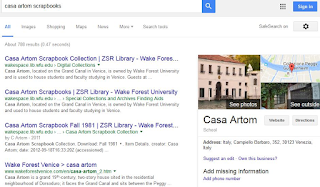 |
| Figure 1: Casa Artom Scrapbooks |
The first
search was a test search, where I searched the name of the collection, which
also happens to be what is contained within the collection - Casa Artom
Scrapbooks. The first result on Google is for the digital collection, the
second is for the finding aid to the physical collection.
 |
| Figure 2: Casa Artom |
In the first ten results, there is nothing about
the scrapbooks, though there are a lot from Wake Forest sites, which may put
someone on the right track.
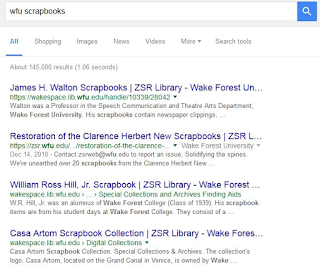 |
| Figure 3: WFU Scrapbooks |
Fourth result, and two of the top three results
also ZSR Scrapbook collections (result two is a blog entry about the
restoration and preservation of a collection, including scrapbooks).
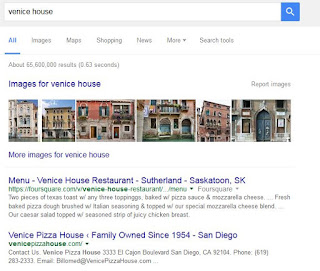 |
| Figure 4: Venice House |
For a lot of people, Casa Artom is referred to
as “Venice House,” as it is WFU’s house in Venice, much like Flow House
(Vienna) is often referred to as “Vienna House.” There were Image results of
houses in Venice, and Venice House seems to be a fairly common name for pizza
restaurant.
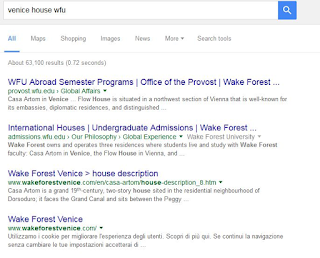 |
| Figure 5: Venice House WFU |
This search brings back two study abroad pages
(one via the provost and one from admissions), and the next two are Casa Artom.
Nothing about the scrapbooks, though.
 |
| Figure 6: Venice House Scrapbooks |
These results speak for themselves, as they have
nothing to do with Casa Artom. While it may be possible for the Casa Artom
Scrapbooks to be in the results, they would be buried under scrapbooking and Pinterest
pages.
 |
| Figure 7: Venice House WFU Scrapbooks |
The person running this search would know what
they are looking for, but not necessarily that they could do this through ZSR’s
website. The first two results are the scrapbook collection, and the next two
are information about Casa Artom. The first result is the finding aid for the
physical scrapbooks and the second is for the digital collection.
 |
| Figure 8: Grand Canal WFU |
This search returns nothing about the
scrapbooks, but a lot about Casa Artom itself, as Casa Artom is situated on the
Grand Canal. This shows that the people creating the metadata were thinking
about how people search.
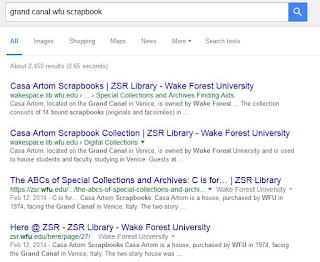 |
| Figure 9: Grand Canal WFU Scrapbook |
The first result is the finding aid for the
physical copies of the scrapbooks, held as reproductions in ZSR. The second
result is the finding aid for the digitized copies of the scrapbooks. The third
result is a blog post by SCA, about the scrapbooks, and contains a hyperlink to
the digital collections page, for better browsing of the scrapbooks.
In
conclusion, the Casa Artom Scrapbooks are findable via a major search engine,
but one would need to know what they are looking for, as totally generic
keywords (scrapbook, Venice, Grand Canal, etc) wouldn’t return the Casa Artom
Scrapbooks. If someone were to search for them using those keywords and “WFU,”
it would greatly increase their chances of getting the results that they were
looking for.
Technology
What sort of
technology is used? Are there outside links to other Digital Libraries, if the
material crosses over to that library’s collection?
Hardware/software Used
Most of
the digital collections do not mention what software they use. However, the
collections held off of WFU (the shared collections) do. For example, the
Biblical Recorder Collection was created using Olive, and Civil War in the
American South was created using Galileo, in conjunction with the Digital
Library of Georgia. Digital NC (Howler, Student, Catalogs and Bulletins, and
Commencement Programs) uses ContentDM for their software. Religion in North
Carolina (a collaborative effort between Duke University, Wake Forest
University and UNC Chapel Hill) is run through the Internet Archive. Digital
Forsyth does not mention what software they use on their website.
Links to other Digital Libraries
As
mentioned, there are many links to larger digital libraries, including Digital
North Carolina, Digital Forsyth, and the Digital Library of Georgia. This made
me wonder if there were any connections between ZSR’s digitized materials and
UNC Greensboro’s digital collections.
I decided
to focus on ZSR’s Lipe Family Civil War Letters as there is a lot of material,
and the Lipe family would have been in North Carolina. I decided to see if I
could connect it to the Greensboro History Collection. Perhaps the Lipe Family
was from Greensboro or corresponded with someone from Greensboro, and therefore
would be in both collections. There were no results in N.C. Runaway Slave
Advertisements (so the Lipes either were not slaveholders or did not put
advertisements in the paper), nor were there any references to them in city
directories. There were some possible results from the Greensboro Patriot, but the text-search feature made it hard to
find the result and decide if it was valid (Lipe Family Civil War Letters).
Regardless,
there were no outside links to the UNC Greensboro Digital Collections.
There
are, as stated above, links to outside collections, but the collection is part
of a large collection, not a direct link between the two collections.
Conclusion
As Keith Gorman (Assistant Dean for Special Collections and
University Archives at Jackson Library, UNC Greensboro) says, “services drive
collections.” He was talking about how Jackson Library decided what to digitize
and how to increase the number of users of the Special Collections and Archives
at UNC Greensboro, but he was completely right. In this case, the service
offered by ZSR’s Digital Collections drive what gets digitized by Digital
Scholarship. And, what the community wants drives what content is added, and
what services are available. If the users wanted a live chat with a member of
SCA staff, that could be added.
In conclusion, ZSR’s Digital Collections are
well integrated between community, content, services, and technology. There is
a lot of overlap, as content creates the community, but the users also help decide
what content gets digitized. The services would not be possible without
technology, and the community decides what types of services help them with the
content. The collaboratively held collections show just how large the community
is, as people in Georgia can use material held at ZSR to help them learn about
the Civil War in the American South.
Works Cited Page
Civil
War in the American South. (2016 January 01). Z. Smith Reynolds Library (Wake
Forest University) All Items. Retrieved
from: http://american-south.org/institutions/ewf/items/ ?Welcome.
Digital
Forsyth. Digital Forsyth. Retrieved from: http://www.digitalforsyth.org/.
Digital
NC. Wake Forest University Magazine. Retrieve from:
http://library.digitalnc.org/ cdm/search/searchterm/Magazines+(periodicals)!Wake%20Forest%20University/field/
format!contri/mode/exact!exact/conn/and!and/cosuppress/.
Digital NC. Wake Forest University Yearbooks (Howler).
Retrieved from: http://library. digitalnc.org/cdm/search/searchterm/Yearbooks!Wake%20Forest%20University/field/
format!contri/mode/exact!exact/conn/and!and/display/200/order/datea/ad/asc.
Marchionini, Gary and Fox, Edward A. (1999). Progress Toward
Digital Libraries: Augmentation through
Integration. Information Processing &
Management, 35(3), 219- 225. Retrieved from: http://uncg.worldcat.org/oclc/425189741.
Special
Collections and Archives – Z. Smith Reynolds Library. Casa Artom Scrapbook Collection.
Retrieved from: https://wakespace.lib.wfu.edu/handle/10339/33254.
Special
Collections and Archives – Z. Smith Reynolds Library. Collection Development
Policy. Retrieved from: http://zsr.wfu.edu/special/about/collection-development-policy/.
Special
Collections and Archives – Z. Smith Reynolds Library. Confederate Broadsides. Retrieved from: https://wakespace.lib.wfu.edu/handle/10339/44.
Special Collections
and Archives – Z. Smith Reynolds Library. Digital Collections. Retrieved from: http://zsr.wfu.edu/special/collections/digital/.
Special
Collections and Archives – Z. Smith Reynolds Library. Lipe Family Civil War
Letters. Retrieved from: https://wakespace.lib.wfu.edu/handle/10339/33600.
Special
Collections and Archives – Z. Smith Reynolds Library. North Carolina Baptist
Historical Collection. Retrieved from: https://wakespace.lib.wfu.edu/handle/10339/33589
Special Collections
and Archives – Z. Smith Reynolds Library. The Biblical Recorder. Retrieved from: http://digital.olivesoftware.com/Default/Skins/WakeforestA/Client.asp?skin=Wake
forestA&AW=1473106068256&AppName=2.
Z. Smith Reynolds Library. (2016, September
02). ZSR Special Collections Reference Desk: Forms
and What to Do with them. Retrieved from: http://guides.zsr.wfu.edu/c.php? g=109801&p=86061.
No comments:
Post a Comment